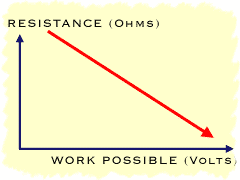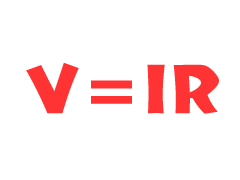Resisting Current
The collisions between electrons and atoms in a conductor cause resistance to the flow of charge. We measure that resistance in order to determine the effect that it will have on current. Scientists measure resistance in ohms (rhymes with homes). There is a magical little formula used to figure out the resistance in an electrical system. That formula is called Ohm's Law, V=IR.Measuring Resistance
 The symbol "V" is used to represent something called the potential difference. Potential difference is the amount of work done in moving a charge between two points, divided by the size of the charge. That's kind of complicated, though. You can think of potential as electrical height. High potential (near positive charge) is kind of like being on top of a hill. Low potential (near negative charge) is kind of like being in a valley. So potential difference indicates the difference in electrical height between two points. The greater that difference, the more likely it is that charge will move. The potential difference is measured in volts, and potential is commonly referred to as voltage. "I" is the symbol for current and "R" is the symbol for the resistance of the system. Current is measured in amperes and resistance is measured in ohms.
The symbol "V" is used to represent something called the potential difference. Potential difference is the amount of work done in moving a charge between two points, divided by the size of the charge. That's kind of complicated, though. You can think of potential as electrical height. High potential (near positive charge) is kind of like being on top of a hill. Low potential (near negative charge) is kind of like being in a valley. So potential difference indicates the difference in electrical height between two points. The greater that difference, the more likely it is that charge will move. The potential difference is measured in volts, and potential is commonly referred to as voltage. "I" is the symbol for current and "R" is the symbol for the resistance of the system. Current is measured in amperes and resistance is measured in ohms.
How can you think of resistance? Have you ever gone to a baseball game? Between innings, we like going to get some food. There are always people between the counter and us. Resistance to current is similar to you trying to make your way through the crowds to get your hot dog. You have to weave your way through the people to reach your goal. The more people in your way, the more resistance. If everyone is in their seats it is super-easy to get your food. There would be very little resistance.
 Let's go back to that equation and look at it in terms of resistance. When you move the values around you get R=V/I. In English that means the resistance of a system is based on voltage and current. Not all conductors follow Ohm's law.
Let's go back to that equation and look at it in terms of resistance. When you move the values around you get R=V/I. In English that means the resistance of a system is based on voltage and current. Not all conductors follow Ohm's law.
Resistance is also based on the resistivity of a material. The resistivity of a material changes because of chemical makeup or the temperature. Copper is a better conductor than wood so copper would have lower resistivity. That resistivity combines with (1) the distance and (2) the space that charges have to move in (thin vs. thick wires) to affect the "R" value. Greater length results in more resistance, and thick wires result in less. When people connect speakers, they usually use wires that are as short and thick as possible.
Knocking Electrons Around
In metals, electrons carry the charges of the current as it flows. What stops the electrons? What offers the resistance to that current? Nothing allows a perfect flow of current, not even superconductors. In metal, there are tiny flaws. You can't see them because they are on a molecular level. Those imperfections cause the electrons to collide with the metal atoms. When they hit the metal, the electrons lose energy. Where does that energy go? It is usually turned into heat. You can watch a hot plate heat up, or maybe a stove top. They heat up because of the collisions between electrons and the metal. Imperfections mean collisions; collisions mean heat.
Or search the sites for a specific topic.
- Overview
- Charges
- Conductors
- Electric Fields
- Magnetic Fields
- Current
- Resistance
- Faraday's Law
- Coulomb's Law
- Magnets
- DC Power
- AC Power
- More Topics

Engineering Electric Propulsion (NASAConnect Video)

Useful Reference Materials
Encyclopedia.com (Current):http://www.encyclopedia.com/topic/electric_current.aspx
Encyclopedia.com (Series Current):
http://www.encyclopedia.com/topic/series_circuit.aspx
Wikipedia:
http://en.wikipedia.org/wiki/Electrical_resistance
Encyclopædia Britannica:
hhttp://www.britannica.com/EBchecked/topic/499254/resistance





